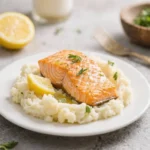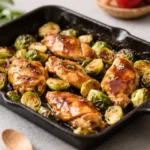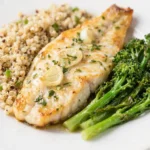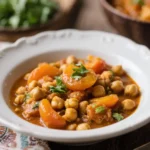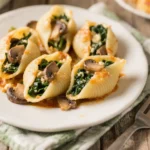Vegan Green Goddess Pasta with Asparagus & Peas
There’s something undeniably magical about a dish that’s as vibrant on the plate as it is nourishing to the body. Enter: Vegan Green Goddess Pasta with Asparagus & Peas—a celebration of springtime flavors, lush green hues, and creamy plant-based indulgence without any dairy in sight. This recipe brings together tender-crisp vegetables, al dente pasta, and a luxuriously creamy avocado-based sauce that will have even non-vegans coming back for seconds. Whether you’re hosting a dinner party, meal prepping for the week, or simply craving a wholesome yet decadent bowl of comfort food, this dish delivers on every front: flavor, texture, nutrition, and visual appeal.
The History
The term “Green Goddess” traces its roots back to early 20th-century American cuisine. The original Green Goddess dressing was created around 1923 at the Palace Hotel in San Francisco. It was named in honor of actor George Arliss, who starred in a play called The Green Goddess. The hotel’s chef crafted an emerald-hued dressing using ingredients like mayonnaise, sour cream, tarragon, chives, anchovies, and scallions to complement the theatrical theme. Over time, the dressing gained popularity and became a staple in American salads and seafood dishes.
Fast forward nearly a century, and the Green Goddess concept has undergone a plant-powered transformation. With rising interest in veganism, clean eating, and whole-food diets, chefs and home cooks alike began reimagining the classic dressing using avocado, cashews, herbs, and lemon juice—ingredients that retain the rich creaminess while aligning with compassionate and health-conscious lifestyles. Our version of Vegan Green Goddess Pasta takes inspiration from both culinary traditions: the elegance of early 20th-century American fine dining and the modern embrace of vibrant, plant-forward meals.
Ingredients Breakdown
This recipe shines not only because of its taste but also due to the thoughtfully selected components that contribute to flavor, texture, and nutrition. Here’s a detailed look at what goes into each element:
- Pasta (Fusilli or Penne): A spiral-shaped pasta like fusilli is ideal because its grooves hold onto the creamy sauce beautifully. Whole grain or legume-based pastas add extra fiber and protein.
- Fresh Asparagus: Thinly sliced on the diagonal, asparagus adds a crisp-tender bite and earthy-sweet flavor. It’s packed with vitamins K, C, folate, and antioxidants.
- Frozen Peas: Convenient and nutrient-dense, peas bring natural sweetness and pop of color. They’re high in plant protein, fiber, and vitamin A.
- Ripe Avocado: The star of the sauce, avocado provides a silky texture and healthy monounsaturated fats. It acts as the base for creaminess without needing dairy.
- Fresh Basil & Parsley: These aromatic herbs lend brightness and depth. Basil offers a slightly sweet, floral note, while parsley adds a clean, grassy freshness.
- Garlic: Minced fresh garlic enhances the savory backbone of the sauce with its pungent kick.
- Lemon Juice: Freshly squeezed lemon juice adds acidity that balances the richness of the avocado and lifts all other flavors.
- Nutritional Yeast: A must-have in vegan kitchens, nutritional yeast imparts a cheesy, umami flavor thanks to its naturally occurring glutamates.
- Olive Oil: Extra virgin olive oil enriches the sauce and helps emulsify it, contributing heart-healthy fats.
- Plant-Based Milk (Unsweetened): Almond, oat, or soy milk thins the sauce to the perfect consistency without overpowering the other ingredients.
- Salt & Black Pepper: Essential seasonings to enhance overall flavor profile.
- Optional Add-ins: Toasted pine nuts, sunflower seeds, red pepper flakes, or vegan parmesan can elevate texture and taste.
Step-by-Step Recipe
- Prepare the Vegetables: Trim the tough ends off the asparagus and slice them diagonally into 1-inch pieces. Measure out the frozen peas—no need to thaw them ahead of time.
- Cook the Pasta: Bring a large pot of salted water to a boil. Add your chosen pasta (about 12 oz) and cook according to package instructions until al dente. Reserve ½ cup of pasta water before draining.
- Blanch the Veggies: In the last 2–3 minutes of pasta cooking time, add the asparagus and peas directly into the boiling water. This gently cooks them while preserving their bright green color and crisp texture. Drain everything together and set aside.
- Make the Green Goddess Sauce: While the pasta is cooking, combine the following in a high-speed blender: 1 ripe avocado, ½ cup fresh basil leaves, ¼ cup fresh parsley, 2 cloves minced garlic, juice of 1 large lemon (about 3 tbsp), 3 tbsp nutritional yeast, ¼ cup extra virgin olive oil, ¼ cup unsweetened plant-based milk, ½ tsp sea salt, and freshly ground black pepper to taste.
- Blend Until Smooth: Blend on high for 45–60 seconds, stopping to scrape down the sides if needed, until the sauce is completely smooth and creamy. If too thick, add more plant milk one tablespoon at a time. Taste and adjust seasoning—add more lemon for tang, salt for savoriness, or nutritional yeast for cheesiness.
- Toss Everything Together: In a large mixing bowl, combine the drained pasta and vegetables. Pour the green goddess sauce over the top and gently fold until everything is evenly coated. If the mixture seems dry, add reserved pasta water 1–2 tablespoons at a time until desired creaminess is reached.
- Serve Immediately: Divide into bowls and garnish with optional toppings such as toasted pine nuts, chopped fresh herbs, cracked black pepper, or vegan parmesan shreds.
Tips
- Use Ripe But Firm Avocados: Overripe avocados can make the sauce overly soft or brown quickly. Choose ones that yield slightly to gentle pressure.
- Prevent Browning: To keep the sauce vibrantly green, use plenty of lemon juice and serve immediately. For leftovers, press plastic wrap directly onto the surface of the sauce to minimize air exposure.
- Boost Flavor with Toasted Nuts: Lightly toast pine nuts or walnuts before sprinkling them on top—they add crunch and deepen the umami notes.
- Double the Sauce: This sauce freezes well! Make extra and store in an airtight container with a thin layer of olive oil on top to preserve color and freshness. Thaw in the fridge and stir before using.
- Add Protein: Toss in cooked chickpeas, white beans, marinated tofu, or tempeh crumbles to turn this into a complete protein-rich meal.
- Don’t Skip the Pasta Water: The starchy liquid helps bind the sauce to the noodles and improves mouthfeel significantly.
- Customize Herb Ratios: Prefer a stronger basil flavor? Increase it. Want more herbaceous punch? Add fresh tarragon or chives.
Variations and Customizations
The beauty of this recipe lies in its versatility. Here are several ways you can adapt it to suit different tastes, dietary needs, or seasonal availability:
- Gluten-Free Version: Use gluten-free pasta made from brown rice, quinoa, or lentils. Ensure all other ingredients (like nutritional yeast) are certified GF if necessary.
- Nut-Free Option: Stick to seed-based milks like oat or hemp, and avoid nut toppings. Sunflower seeds work great as a crunchy alternative to pine nuts.
- Creamier Sauce Base: Replace half the avocado with raw cashews (soaked for 2+ hours) for an even richer texture and milder flavor.
- Different Veggies: Swap asparagus for zucchini ribbons, broccoli florets, spinach, green beans, or artichoke hearts. Roasted cherry tomatoes add a sweet contrast.
- Keto-Friendly Adaptation: Use spiralized zucchini (zoodles) or shirataki noodles instead of traditional pasta. Reduce peas (higher carb) and increase low-carb greens.
- Spicy Kick: Add ½ teaspoon smoked paprika, a pinch of cayenne, or a few drops of hot sauce to the blender for heat.
- Herb Swaps: Try adding dill, mint, cilantro, or tarragon for unique twists. Each brings a new dimension to the Green Goddess profile.
- Meal Prep Friendly: Store components separately—cooked pasta, blanched veggies, and sauce—and assemble when ready to eat. Best consumed within 2 days for optimal color and texture.
Health Considerations and Nutritional Value
Vegan Green Goddess Pasta isn’t just delicious—it’s a powerhouse of nutrients that supports overall wellness. Let’s break down why this dish earns its place in a balanced diet:
- Heart-Healthy Fats: Avocado and olive oil provide monounsaturated fats that support cardiovascular health, reduce inflammation, and improve cholesterol levels.
- Fiber-Rich: Whole grain pasta, peas, asparagus, and avocado contribute significant dietary fiber, promoting digestive health and sustained energy.
- Plant-Based Protein: Peas offer about 8g of protein per cup, and pairing them with legume-based pasta or added beans boosts the total protein content further.
- Vitamin Powerhouse: Packed with vitamins A, C, E, K, and B6, plus folate and potassium. Asparagus is especially rich in vitamin K, crucial for bone and blood health.
- Antioxidant Boost: The colorful blend of green vegetables and herbs contains chlorophyll, lutein, zeaxanthin, and flavonoids that combat oxidative stress.
- Dairy-Free & Cholesterol-Free: Naturally free from animal products, making it suitable for those managing lactose intolerance, heart disease, or cholesterol concerns.
- Low in Added Sugar: Unlike many commercial dressings, this homemade version contains no refined sugars—just natural sweetness from peas and herbs.
- Supports Gut Health: Fiber from vegetables and whole grains feeds beneficial gut bacteria, supporting microbiome balance.
Nutritional Estimate (per serving, serves 4):
- Calories: ~450 kcal
- Total Fat: 22g (mostly healthy fats)
- Saturated Fat: 3g
- Carbohydrates: 56g
- Dietary Fiber: 12g
- Sugars: 8g (naturally occurring)
- Protein: 14g
- Sodium: 400mg (adjustable based on salt used)
- Vitamins: High in Vitamins A, C, K, Folate, and Potassium
Ingredients
- 12 oz (340g) fusilli, penne, or preferred pasta (whole grain or legume-based recommended)
- 1 bunch fresh asparagus (about 1 lb), trimmed and sliced diagonally
- 1 cup (150g) frozen peas
- 1 large ripe avocado
- ½ cup fresh basil leaves, packed
- ¼ cup fresh flat-leaf parsley, packed
- 2 cloves garlic, minced
- Juice of 1 large lemon (approx. 3 tbsp)
- 3 tbsp nutritional yeast
- ¼ cup extra virgin olive oil
- ¼ cup unsweetened almond milk (or oat/soy milk)
- ½ tsp sea salt (or to taste)
- Freshly ground black pepper, to taste
- Optional: 2–4 tbsp reserved pasta water
- Garnishes: toasted pine nuts, vegan parmesan, red pepper flakes, extra herbs
Directions
- Fill a large pot with water, add a generous pinch of salt, and bring to a rolling boil.
- Add the pasta and cook according to package directions until al dente.
- About 2–3 minutes before the pasta finishes cooking, add the sliced asparagus and frozen peas to the pot. Cook together, then drain and reserve ½ cup of the starchy pasta water.
- In a high-speed blender, combine the avocado, basil, parsley, garlic, lemon juice, nutritional yeast, olive oil, plant-based milk, salt, and pepper.
- Blend on high speed for 45–60 seconds, or until completely smooth and creamy. Stop and scrape down the sides as needed. Add additional plant milk (1 tbsp at a time) if the sauce is too thick.
- Transfer the drained pasta, asparagus, and peas to a large serving bowl.
- Pour the green goddess sauce over the warm pasta mixture.
- Using tongs or a large spoon, gently toss until everything is evenly coated. If the sauce feels too thick, add reserved pasta water 1–2 tablespoons at a time until creamy and glossy.
- Taste and adjust seasoning—add more lemon juice for brightness, salt for flavor, or nutritional yeast for a cheesier note.
- Divide among plates or bowls and garnish generously with toasted pine nuts, cracked black pepper, fresh herbs, or vegan cheese.
- Serve immediately for the best flavor and color.
FAQ
Can I make this recipe ahead of time?
Yes, but with some caveats. The sauce is best when fresh to prevent oxidation (browning). However, you can prep ingredients in advance: cook the pasta and veggies, store separately, and blend the sauce just before serving. Alternatively, press plastic wrap directly onto the sauce surface and refrigerate for up to 1 day.
Can I freeze the green goddess sauce?
Yes! Freeze the sauce in an ice cube tray or airtight container for up to 2 months. Thaw in the refrigerator overnight and stir well before using. Note: texture may be slightly softer after freezing.
Is this recipe kid-friendly?
Absolutely! Many children love the creamy texture and mild flavor. You can reduce garlic or add a touch of maple syrup to balance bitterness if needed. Serve with fun-shaped pasta for extra appeal.
Why is my sauce too thick or too thin?
Too thick? Add more plant milk or reserved pasta water. Too thin? Blend in another half an avocado or a tablespoon of raw cashews to thicken.
Can I use dried herbs instead of fresh?
Not recommended. Dried herbs lack the bright, fresh flavor essential to a true Green Goddess sauce. Fresh herbs are key to achieving the signature taste and color.
What can I pair with this pasta?
It pairs beautifully with a crisp green salad, garlic bread, roasted vegetables, or grilled tofu. For wine lovers, try a chilled Sauvignon Blanc or Pinot Grigio.
Summary
Vegan Green Goddess Pasta with Asparagus & Peas is a vibrant, creamy, and nutritious plant-based meal that celebrates fresh seasonal produce and bold herb flavors—all without a drop of dairy. Packed with fiber, healthy fats, and essential vitamins, it’s as wholesome as it is delicious.

